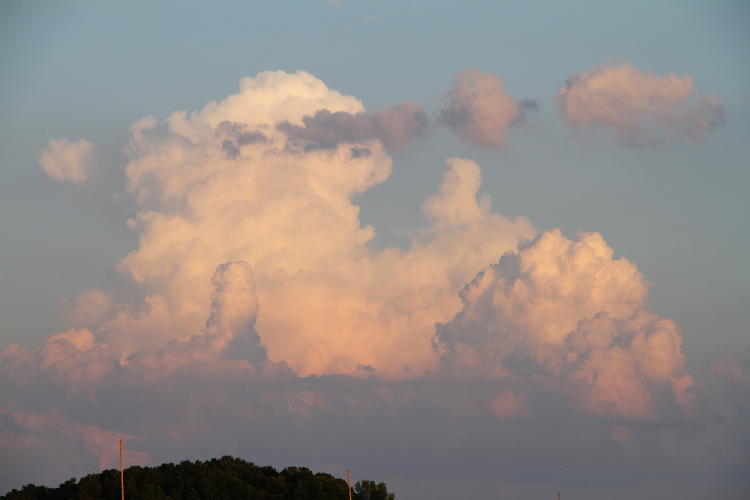
So, Monday night I went down to the lake to try again on those focus and tracking tests. The light was again ideal, only this time, it remained that way until the sun disappeared behind the trees. Unfortunately, I saw even fewer birds than before. I may be partially to blame here, since we’re now past nesting season and the adults have much less to do with no babies to feed. Some blame might also be placed on the ridiculous number of boaters that were out there, mostly kayakers, paddleboarders, and related; there weren’t too many open patches nearby where an osprey might feel safe to dive. So while there, I settled on shooting some of the developing cumulonimbus clouds lit by the westering sun, like the oddly tumescent one above, happy to see someone, at least.
But then again, it didn’t last long, and I’ll leave you to speculate with whatever indelicate explanations come to mind. I’m certainly above all that. Unlike this cloud.
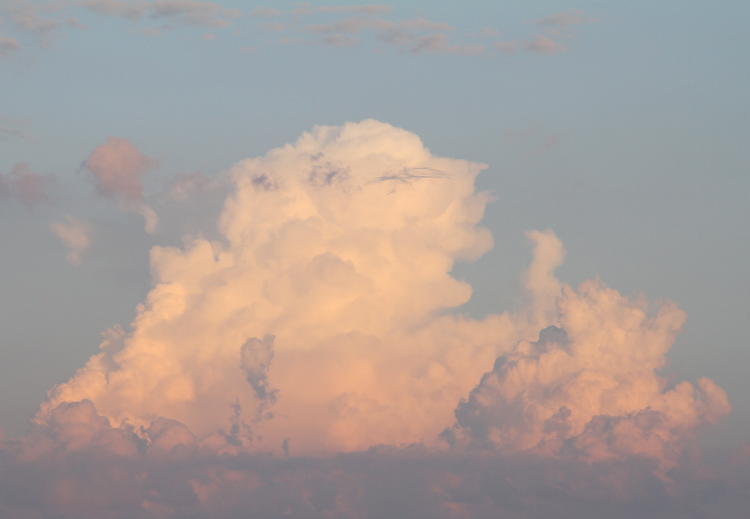
What does show here, though, are the range of colors that extend in layers as the sun sets, cutting through thicker and thicker portions of the atmosphere. It became a little more evident as the evening wore on.
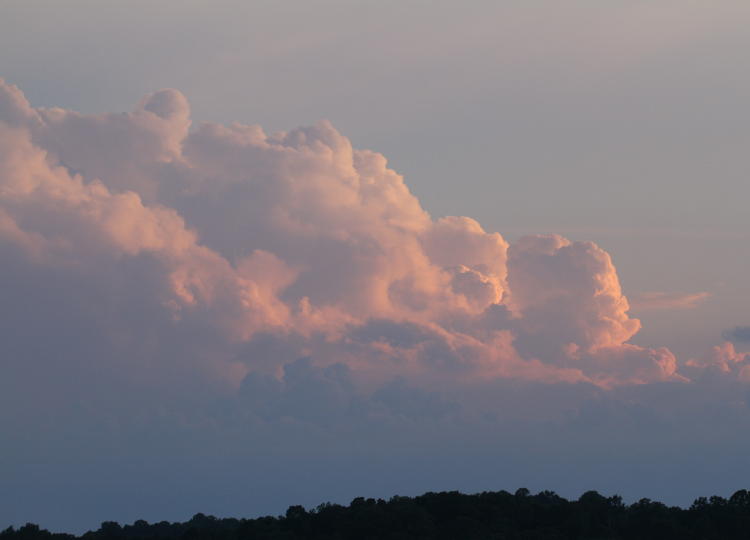
This coloration, as I’ve said before, is known as the ‘Belt of Venus,’ and is essentially the shadow of the earth itself being cast onto the clouds as the sun disappears over the horizon, the shadow leaping up from the horizon. Of course, some of this might also be from the other clouds in the area blocking the sun, but it’s pretty much the same effect, and same color progression. There were no high altitude clouds at all, so nothing to really color the sky, just these fluffy monsters clustered down low in various places. I was watching them with interest, knowing that they often turned into thunderheads, and being down on the lake I’d have a good view.
But I also fired off a few test shots here and there, such as at passing airliners, which are quite small in the viewfinder and thus not bad for focus targets in that regard, but far too easy to track so not the kind of test I was really after.

Now here’s the serendipitous part, because I knew conditions were right for something in particular, that I actually captured in that frame, but I didn’t know it until I got back and unloaded the card – if your monitor is not well-corrected it would be easy to miss. Let’s go a little closer.

See it? There’s a super-thin crescent moon in the photo. Amusingly, I started actively looking for it immediately after firing off that frame, but took another couple of minutes before I snagged it. I knew we were just past new moon and the crescent would be visible soon after sunset, but it was a little more advanced than my previous shots done some months back, which became evident as the evening wore on. Had I been out the previous night, it likely would have been too thin to discern, closer to the sun and swallowed up in the glare, and it wasn’t until he sky started to darken a bit before it could be made out.
But we’ll pause here for a little curiosity, because I spotted this as I was looking, before I even made out the moon.
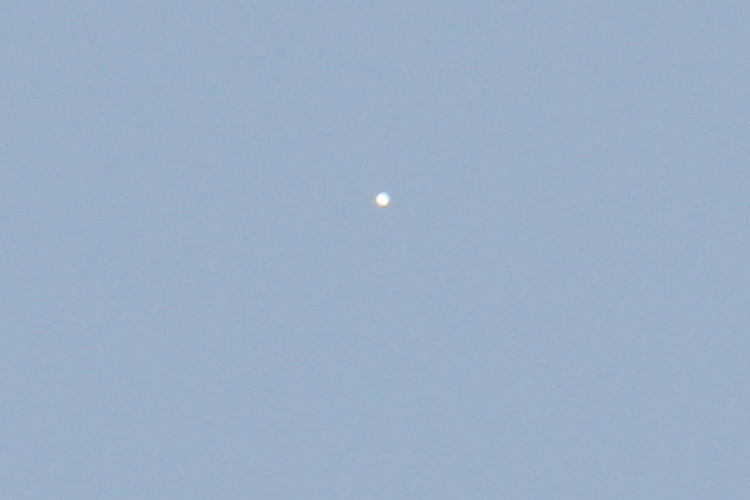
This is cropped down to full resolution, but even in the viewfinder I could make out that it was larger than a star, and the subsequent frame showed it as distinctly round. Not current on my orbital times, I initially identified it as Venus, then thought better of it and considered Jupiter instead. Upon my return, I booted Stellarium to confirm – and found neither. There were, in fact, no planets at all anywhere in the vicinity, and this is way too big and round to be a star. So what did I capture? There was no visible motion, but I don’t recall seeing it again either, so I’m leaning towards a high-altitude object reflecting the sun, such as, yes, a weather balloon – they’ve been proven to exist, unlike just about every other explanation certain types of people tend to put forth. I’m going to have to go onto some astronomy forums and see what can be found. The worst part is, I have only a rough idea of altitude and azimuth, which would have helped significantly.
Back to the moon.
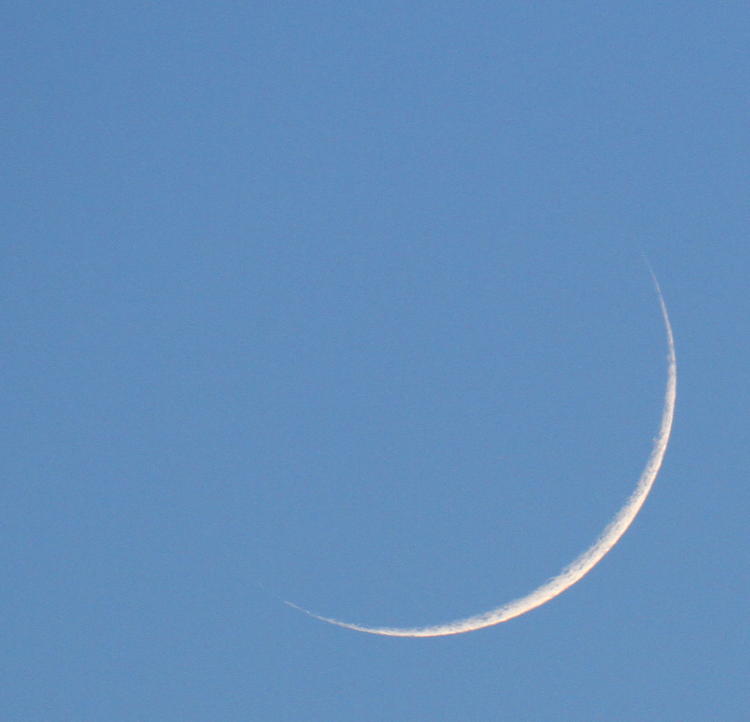
I did a lot of focus bracketing with these, not trusting autofocus at all, and managed to get a few frames that actually show a vestige of lunar detail, so I’m cool. Stellarium pegged this as 3% illuminated, while that time back in January was about 1%, but in order to get it less than that, I would have had to have caught it sometime during the morning, when it would have been impossible to make out without a telescope. As I said in that January post, it varies a lot.
Not knowing that I already had one, I got lucky and fired off a few frames as a jet passed nearby.
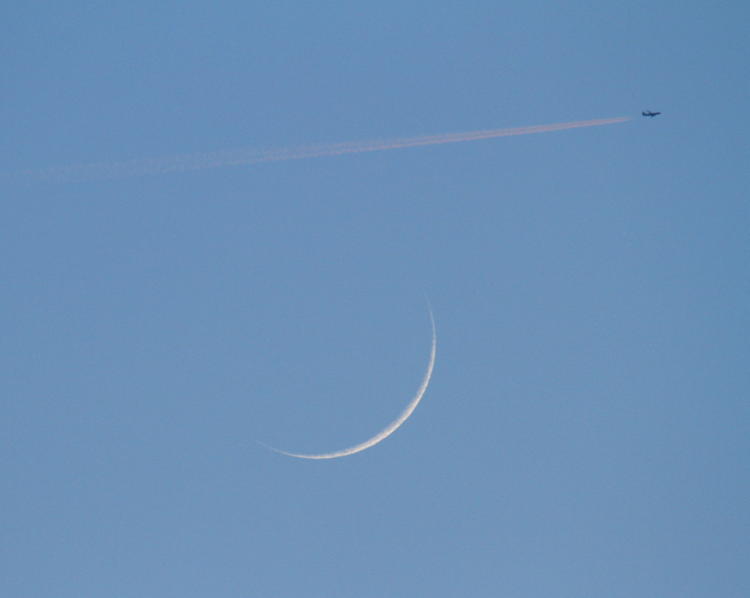
Notice how the contrails are colored red by the sunset, long gone from my perspective but still visible to those passengers and crew. The moon was of course below them and not visible at all.
(All right, we all know that’s bullshit – the moon was in the same position for them as it was for me. But likely not visible to them, because they still had some sunlight glare in the sky that probably overwhelmed it.)
Now it gets a little bit cooler.

When I first saw it in the viewfinder, I wasn’t sure I wasn’t just imagining it, but as it got a little later, the earthshine became evident. I did a little playing around in GIMP with the two images above, and in the one with the plane, I couldn’t coax any evidence of earthshine out of the image at all, but in the one immediately above where it shows distinctly, I could actually make out the lunar mares if I pushed it to extremes. Now I’m annoyed that I didn’t switch over to RAW mode for a few frames, because this is exactly where that additional range and info would come into play.
As the moon was approaching the trees and about to disappear, I resolved to shoot video of it to show the actual speed of movement, but I was still glancing around, and one of the many developing thunderheads was now showing regular activity. I watched it but shot no photos or video, wanting to time things just right for the moon, and as it turns out, the resulting video is dark enough not to show much of any light from the sky at all, and no earthshine (I didn’t expect a lot from 30 frames per second, even with widely expanded ISO,) and I was missing the peak of activity from the thunderhead. When I finally turned to shoot it once the moon was out of sight, the sky now being dark enough for some longer exposures, the activity was tapering off.

It’s kind of a shame, because this thunderhead was actually drawing a little closer, and I might have gotten some nice shots out over the lake, but it simply evolved into rain, and none of the others were putting in quite enough effort. I could only guess how far south this was from my position, but that guess is a couple dozen kilometers or better.
Yet I did get one nice capture.
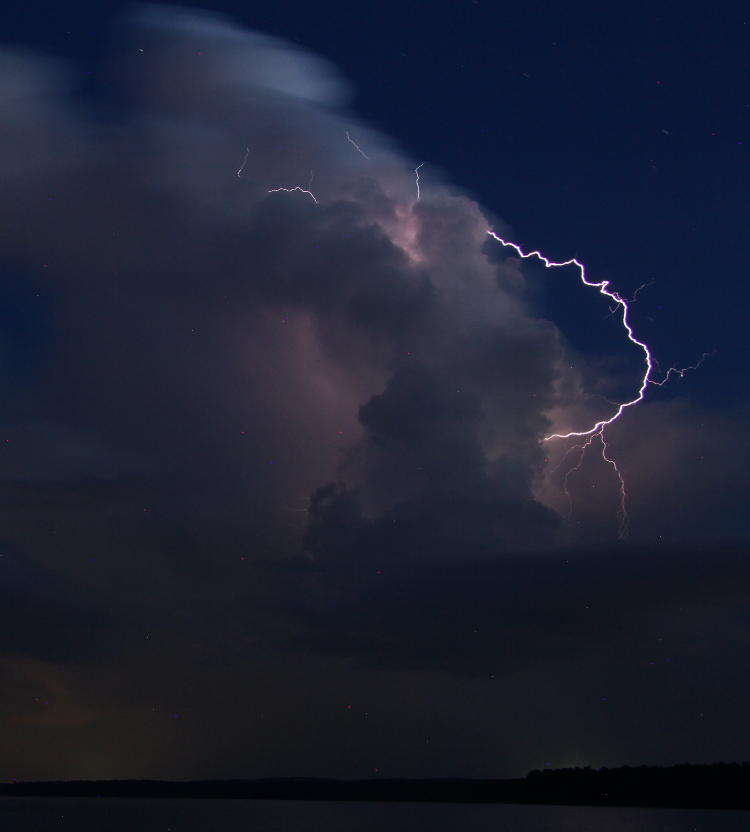
I don’t pretend to understand why lightning would loop around like this, but it’s cool-looking, so I’m groovy. Notice the difference in the clouds, where portions are illuminated by the dim lingering twilight and show the motion of the clouds during the long exposure, while a portion is illuminated by the brief lightning itself and is thus sharp in that burst of light. And yes, there’s a lot of sensor noise present, because I didn’t do any noise reduction tricks for this post, but we’ll all just have to cope.
One of these days, I’ll get some birds to practice on. I promise to let you know when I do – it’s starting to feel like some epic quest now. Geez, I just want a few birds…



















































